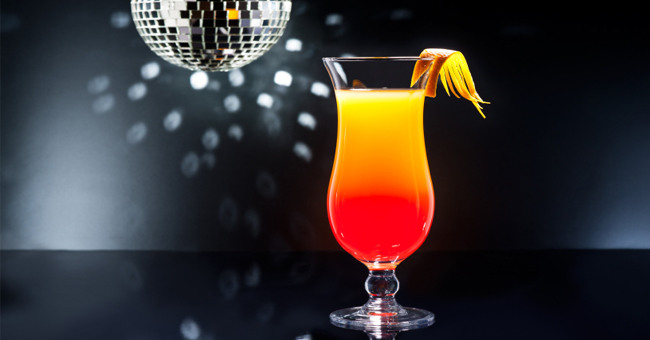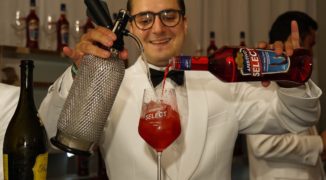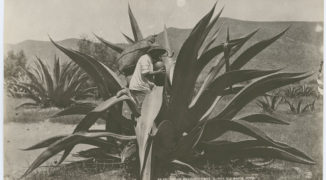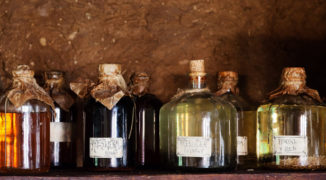Saddle up at your average dive bar, order a tequila sunrise, and take a sip, and you’ll most likely remember why this drink is lumped in with a class of cocktails born in what many consider to be “the Dark Ages” of mixology. But what you may not know is that this classic, syrupy low-brow staple wasn’t actually a product of the ‘70s, despite having risen to ubiquity alongside the likes of Don Henley.
“The Tequila Sunrise was actually invented at Agua Caliente, a huge Prohibition-era resort in Tijuana,” explains Dave Wondrich, spirits historian and author of bestsellers “Punch” and “Imbibe.” “It was a place where people from Southern California could go drink, gamble, bet on the horses… it had a track, a hotel, a casino, so all the Hollywood people would fly down there,” he says. Wondrich describes the original drink as a tequila daisy, with the addition of a little bit of creme de cassis. (It’s worth noting that Arizona’s Biltmore Bar also claims to be the original creator of the drink, around the same time period.)
Fast-forward to the ‘60s, where a joint called the Trident Bar was slinging drinks to the rock ‘n roll set just outside of San Francisco in Sausalito. (Coincidentally, the modern-day owners of the Trident also operate the Buena Vista Cafe, where the Irish coffee was first popularized in the U.S.) At the Trident, Wondrich explains, little heed was paid to the precision of a given recipe — “they kind of did their own thing,” he says. Their version of the tequila sunrise, which is what most of us know today, nixed the cassis and kept the grenadine. Perhaps more significantly, it was also fed to rock stars.
“The Rolling Stones came in one day in 1972, and they made that drink for Mick Jagger,” Wondrich says. Bobby Lozhoff is the bartender credited with first serving the drink to the Stones’ lead vocalist. “Mick Jagger liked it, so they took it on tour with them in their famous 1972 tour that basically broke America,” adds Wondrich. The tour, which followed the release of “Exile on Main Street,” was and still is legendary for its debauchery, rowdiness, and violence: a rigamarole of arrests, tear gas, riots, counterfeit tickets, more riots, on-stage pie fights, nights at the Playboy Mansion, jail, bail, and tequila-stocked limousines. Decades later, in his 2010 autobiography “Life,” Keith Richards mentioned that the tour’s informal moniker was the “Cocaine and Tequila Sunrise Tour.” The following year, after the tequila sunrise fueled one of the most riotous rock ‘n roll tours in American history, it graced the lyrics of the Eagles’ 1973 hit single. And, for the next decade or so, it would be a drinking fixture at nightclubs, dive bars and suburban dinner parties alike.
From there, the tequila sunrise took its rightful place among the Rusty Nails, Screwdrivers, and their kin: the cocktails that defined an era, for better or worse. (Worse, most likely — some would argue that the ‘70s and ‘80s very nearly destroyed cocktail culture in America, a setback from which we’ve only recently begun to recover.) “It’s a funny, interesting drink, historically, because it illuminates two distinct phases of drinking culture,” Wondrich says, contrasting the inventiveness and simplicity of Prohibition’s golden age of cocktails with the anything-goes, syrupy, neon-tinged concoctions of the ’70s and ’80s.
Of course, many a great bartender looks to history for inspiration, and in recent years, this very class of drinks is being resurrected anew at bars around the country, swapping in higher-quality spirits and house-made modifiers. Is it better to leave these drinks safely locked away in the past? Wondrich thinks so: he contends that when it comes to mediocre drinks, sometimes it’s best to leave well enough alone. “Let it age quietly,” he says. (He concedes that this is an argument he has with plenty of his fellow drinkers.)
But judging by the many bartenders who’ve attempted craft makeovers on a Fuzzy Navel, it’s up for debate. After all, if the creations of Jerry Thomas, Harry Craddock, and Trader Vic are worthy of a revival, why not those of Bobby Lozhoff and Brian Flanagan? Many bartenders would probably say “because the drinks were terrible,” but perhaps that just means there’s no better reason to grant these concoctions a second chance.
Besides, it was good enough for Mick Jagger.





